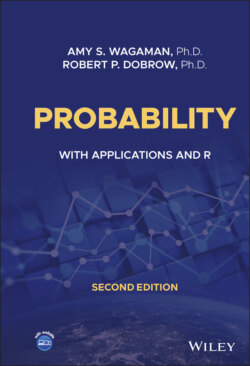Читать книгу Probability - Robert P. Dobrow - Страница 26
Multiplication principle
ОглавлениеIf there are ways for one thing to happen, and ways for a second thing to happen, there are ways for both things to happen.
More generally—and more formally—consider an -element sequence If there are possible values for the first element, possible values for the second element, , and possible values for the th element, there are possible sequences.
For instance, in tossing a coin three times, there are possible outcomes. Rolling a die four times gives possible rolls.
Example 1.11 License plates in Minnesota are issued with three letters from A to Z followed by three digits from 0 to 9. If each license plate is equally likely, what is the probability that a random license plate starts with G-Z-N?The solution will be equal to the number of license plates that start with G-Z-N divided by the total number of license plates. By the multiplication principle, there are possible license plates.For the number of plates that start with G-Z-N, think of a six-element plate of the form G-Z-N---. For the three blanks, there are 10 possibilities. Thus, the desired probability is
Example 1.12 A DNA strand is a long polymer string made up of four nucleotides—adenine, cytosine, guanine, and thymine. It can be thought of as a sequence of As, Cs, Gs, and Ts. DNA is structured as a double helix with two paired strands running in opposite directions on the chromosome. Nucleotides always pair the same way: A with T and C with G. A palindromic sequence is equal to its “reverse complement.” For instance, the sequences CACGTG and TAGCTA are palindromic sequences (with reverse complements GTGCAC and ATCGAT, respectively), but TACCAT is not (reverse complement is ATGGTA). Such sequences play a significant role in molecular biology.Suppose the nucleotides on a DNA strand of length six are generated in such a way so that all strands are equally likely. What is the probability that the DNA sequence is a palindromic sequence?By the multiplication principle, the number of DNA strands is because there are four possibilities for each site. A palindromic sequence of length six is completely determined by the first three sites. There are palindromic sequences. The desired probability is
Example 1.13 Logan is taking four final exams next week. His studying was erratic and all scores A, B, C, D, and F are equally likely for each exam. What is the probability that Logan will get at least one A?Take complements (often an effective strategy for “at least” problems). The complementary event of getting at least one A is getting no A's. As outcomes are equally likely, by the multiplication principle there are exam outcomes with no A's (four grade choices for each of four exams). And there are possible outcomes in all. The desired probability is
